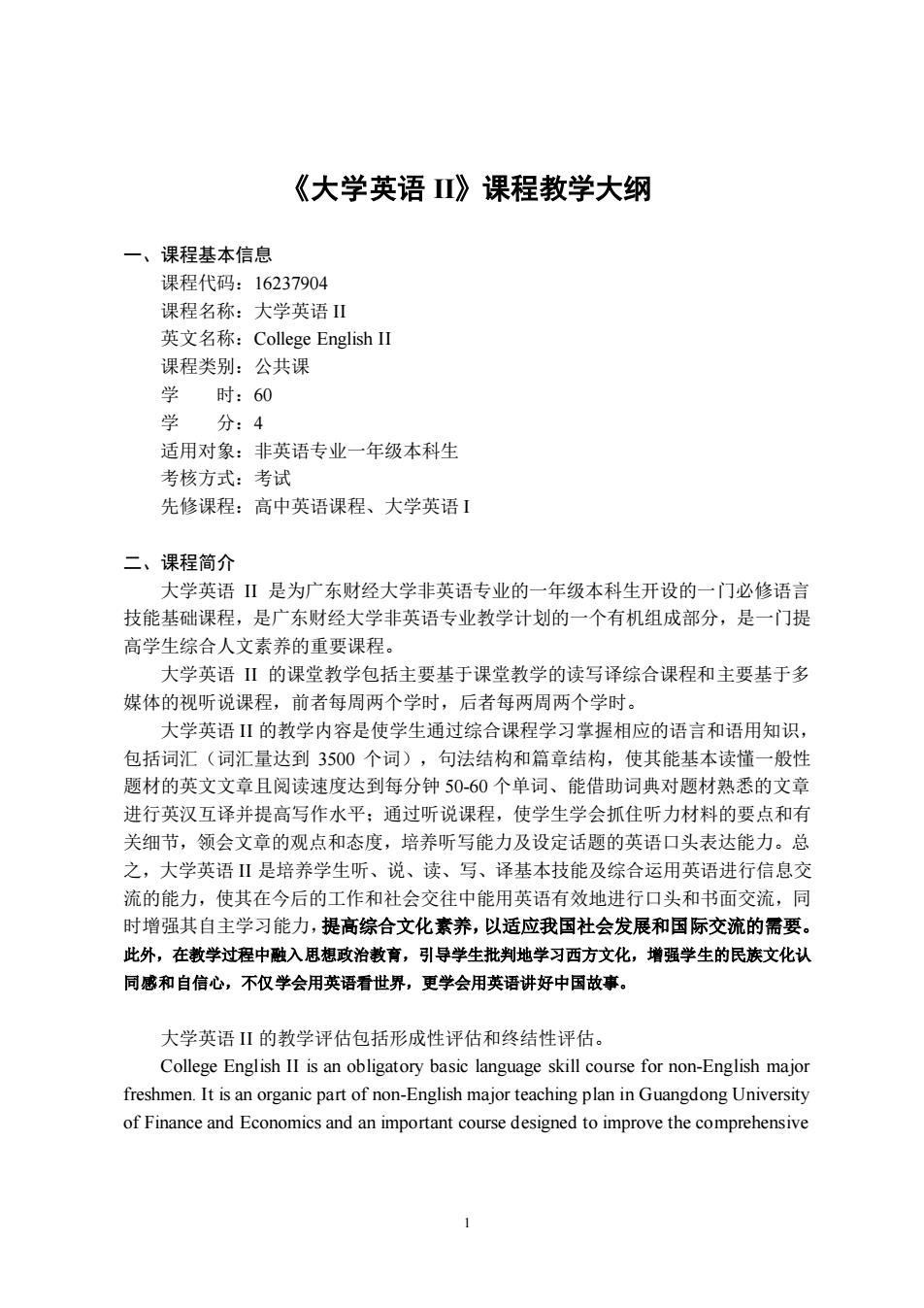
《大学英语Ⅱ》课程教学大纲 一、课程基本信息 课程代码:16237904 课程名称:大学英语Ⅱ 英文名称:College English IⅡ 课程类别:公共课 时:60 学分:4 适用对象:非英语专业一年级本科生 考核方式:考试 先修课程:高中英语课程、大学英语1 二、课程简介 大学英语Ⅱ是为广东财经大学非英语专业的一年级本科生开设的一门必修语言 技能基础课程,是广东财经大学非英语专业教学计划的一个有机组成部分,是一门提 高学生综合人文素养的重要课程。 大学英语Ⅱ的课堂教学包括主要基于课堂教学的读写译综合课程和主要基于多 媒体的视听说课程,前者每周两个学时,后者每两周两个学时。 大学英语Ⅱ的教学内容是使学生通过综合课程学习掌握相应的语言和语用知识, 包括词汇(词汇量达到3500个词),句法结构和篇章结构,使其能基本读懂一般性 题材的英文文章且阅读速度达到每分钟5060个单词、能借助词典对题材熟悉的文章 进行英汉互译并提高写作水平;通过听说课程,使学生学会抓住听力材料的要点和有 关细节,领会文章的观点和态度,培养听写能力及设定话题的英语口头表达能力。总 之,大学英语Ⅱ是培养学生听、说、读、写、译基本技能及综合运用英语进行信息交 流的能力,使其在今后的工作和社会交往中能用英语有效地进行口头和书面交流,同 时增强其自主学习能力,提高综合文化素养,以适应我国社会发展和国际交流的需要。 此外,在教学过程中融入思想政治教育,引导学生批判地学习西方文化,增强学生的民族文化认 同感和自信心,不仅学会用英语看世界,更学会用英语讲好中国故事。 大学英语Ⅱ的教学评估包括形成性评估和终结性评估。 College English II is an obligatory basic language skill course for non-English major freshmen.It is an organic part of non-English major teaching plan in Guangdong University of Finance and Economics and an important course designed to improve the comprehensive
1 《大学英语 II》课程教学大纲 一、课程基本信息 课程代码:16237904 课程名称:大学英语 II 英文名称:College English II 课程类别:公共课 学 时:60 学 分:4 适用对象:非英语专业一年级本科生 考核方式:考试 先修课程:高中英语课程、大学英语 I 二、课程简介 大学英语 II 是为广东财经大学非英语专业的一年级本科生开设的一门必修语言 技能基础课程,是广东财经大学非英语专业教学计划的一个有机组成部分,是一门提 高学生综合人文素养的重要课程。 大学英语 II 的课堂教学包括主要基于课堂教学的读写译综合课程和主要基于多 媒体的视听说课程,前者每周两个学时,后者每两周两个学时。 大学英语 II 的教学内容是使学生通过综合课程学习掌握相应的语言和语用知识, 包括词汇(词汇量达到 3500 个词),句法结构和篇章结构,使其能基本读懂一般性 题材的英文文章且阅读速度达到每分钟 50-60 个单词、能借助词典对题材熟悉的文章 进行英汉互译并提高写作水平;通过听说课程,使学生学会抓住听力材料的要点和有 关细节,领会文章的观点和态度,培养听写能力及设定话题的英语口头表达能力。总 之,大学英语 II 是培养学生听、说、读、写、译基本技能及综合运用英语进行信息交 流的能力,使其在今后的工作和社会交往中能用英语有效地进行口头和书面交流,同 时增强其自主学习能力,提高综合文化素养,以适应我国社会发展和国际交流的需要。 此外,在教学过程中融入思想政治教育,引导学生批判地学习西方文化,增强学生的民族文化认 同感和自信心,不仅学会用英语看世界,更学会用英语讲好中国故事。 大学英语 II 的教学评估包括形成性评估和终结性评估。 College English II is an obligatory basic language skill course for non-English major freshmen. It is an organic part of non-English major teaching plan in Guangdong University of Finance and Economics and an important course designed to improve the comprehensive
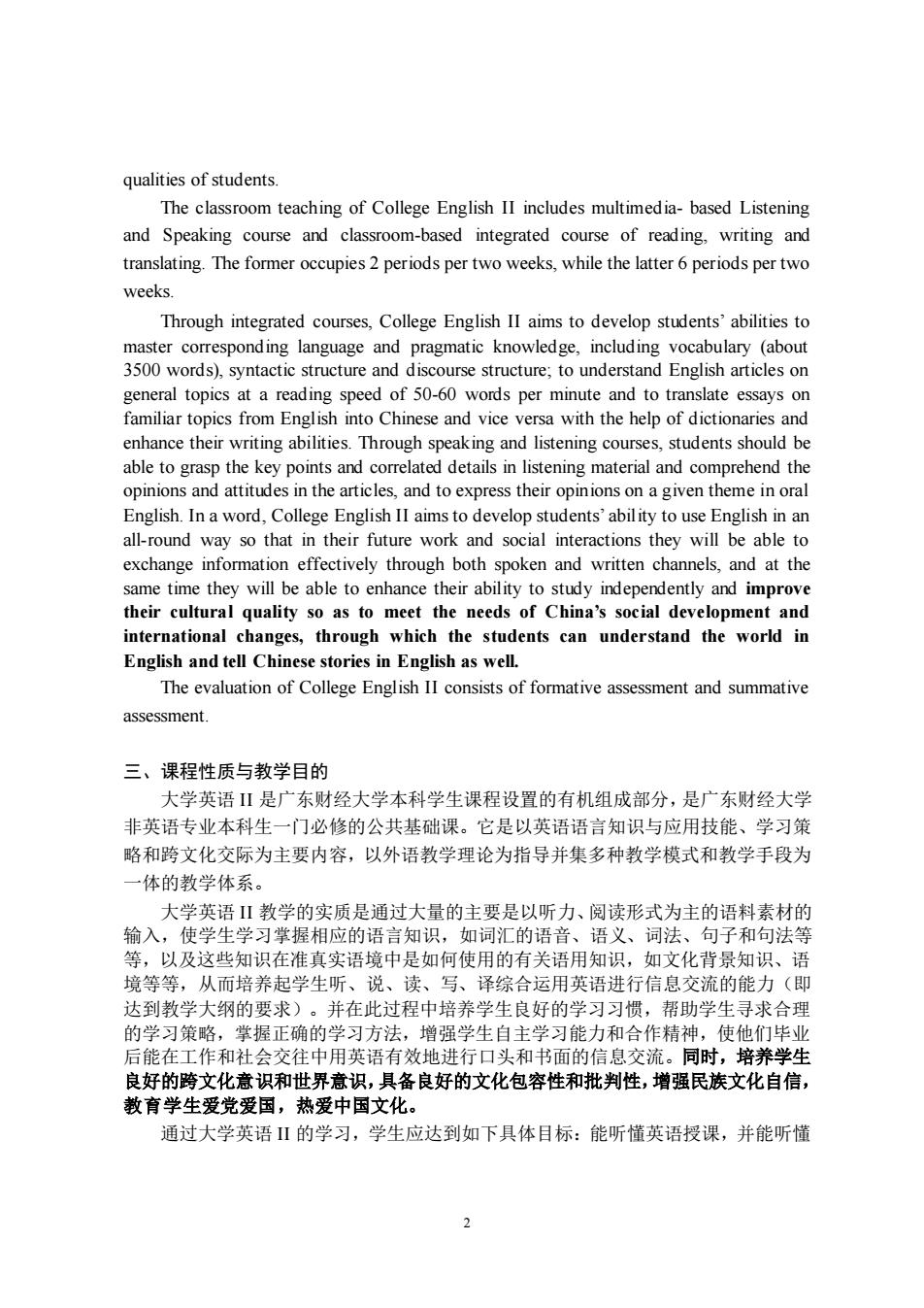
qualities of students. The classroom teaching of College English II includes multimedia-based Listening and Speaking course and classroom-based integrated course of reading,writing and translating.The former occupies 2 periods per two weeks,while the latter 6 periods per two weeks. Through integrated courses.College English II aims to develop students'abilities to master corresponding language and pragmatic knowledge.including vocabulary (about 3500 words).syntactic structure and discourse structure:to understand English articles on general topics a read d of 50-60 words pe slate ess familiar topics from English into Chinese and vice versa with the help of dictionaries and enhance their writing abilities.Through speaking and listening courses,students should be able to grasp the key points and correlated details in listening material and comprehend the opinions and attitudes in the articles,and to express their opinions on a given theme in oral English.Ina word,College English II aims to develop students'ability to use English in a all- ound way so that in their future work and social interactions they will be able to exchange information effectively through both spoken and written channels,and at the same time they will be able to enhance their ability to study independently and improve their cultural quality so as to meet the needs of China's social development and international changes,through which the students can understand the world in English and tell Chinese stories in English as well. The evaluation of College English II consists of formative assessment and summative assessment. 三、课程性质与教学目的 大学英语是广东财经大学本科学生课程设胃的有机组成部分,是广东财经大学 非英语专业本科生一门必修的公共基础课。它是以英语语言知识与应用技能、学习策 略和跨文化交际为主要内容,以外语教学理论为指导并集多种教学模式和教学手段为 体的教学体系。 大学英语Ⅱ教学的实质是通过大量的主要是以听力、阅读形式为主的语料素材的 输入,使学生学习掌握相应的语言知识,如词汇的语音、语义、词法、句子和句法等 等,以及这些知识在准真实语境中是如何使用的有关语用知识,如 化背景知识、语 境等等,从而培养起学生听、说、读 司、译综合运用英语进行信息交流的能力( 达到教学大纲的要求)。并在此过程中培养学生良好的学习习惯,帮助学生寻求合理 的学习策略,掌握正确的学习方法,增强学生自主学习能力和合作精神,使他们毕业 后能在工作和社会交往中用英语有效地进行口头和书面的信息交流。同时,培养学生 良好的畸文化意识和世界意识,具备良好的文化包容性和批判性,增强民族文化自信, 教育学生爱党爱国,热爱中国文化。 通过大学英语Ⅱ的学习,学生应达到如下具体目标:能听懂英语授课,并能听懂 2
2 qualities of students. The classroom teaching of College English II includes multimedia- based Listening and Speaking course and classroom-based integrated course of reading, writing and translating. The former occupies 2 periods per two weeks, while the latter 6 periods per two weeks. Through integrated courses, College English II aims to develop students’ abilities to master corresponding language and pragmatic knowledge, including vocabulary (about 3500 words), syntactic structure and discourse structure; to understand English articles on general topics at a reading speed of 50-60 words per minute and to translate essays on familiar topics from English into Chinese and vice versa with the help of dictionaries and enhance their writing abilities. Through speaking and listening courses, students should be able to grasp the key points and correlated details in listening material and comprehend the opinions and attitudes in the articles, and to express their opinions on a given theme in oral English. In a word, College English II aims to develop students’ ability to use English in an all-round way so that in their future work and social interactions they will be able to exchange information effectively through both spoken and written channels, and at the same time they will be able to enhance their ability to study independently and improve their cultural quality so as to meet the needs of China’s social development and international changes, through which the students can understand the world in English and tell Chinese stories in English as well. The evaluation of College English II consists of formative assessment and summative assessment. 三、课程性质与教学目的 大学英语 II 是广东财经大学本科学生课程设置的有机组成部分,是广东财经大学 非英语专业本科生一门必修的公共基础课。它是以英语语言知识与应用技能、学习策 略和跨文化交际为主要内容,以外语教学理论为指导并集多种教学模式和教学手段为 一体的教学体系。 大学英语 II 教学的实质是通过大量的主要是以听力、阅读形式为主的语料素材的 输入,使学生学习掌握相应的语言知识,如词汇的语音、语义、词法、句子和句法等 等,以及这些知识在准真实语境中是如何使用的有关语用知识,如文化背景知识、语 境等等,从而培养起学生听、说、读、写、译综合运用英语进行信息交流的能力(即 达到教学大纲的要求)。并在此过程中培养学生良好的学习习惯,帮助学生寻求合理 的学习策略,掌握正确的学习方法,增强学生自主学习能力和合作精神,使他们毕业 后能在工作和社会交往中用英语有效地进行口头和书面的信息交流。同时,培养学生 良好的跨文化意识和世界意识,具备良好的文化包容性和批判性,增强民族文化自信, 教育学生爱党爱国,热爱中国文化。 通过大学英语 II 的学习,学生应达到如下具体目标:能听懂英语授课,并能听懂
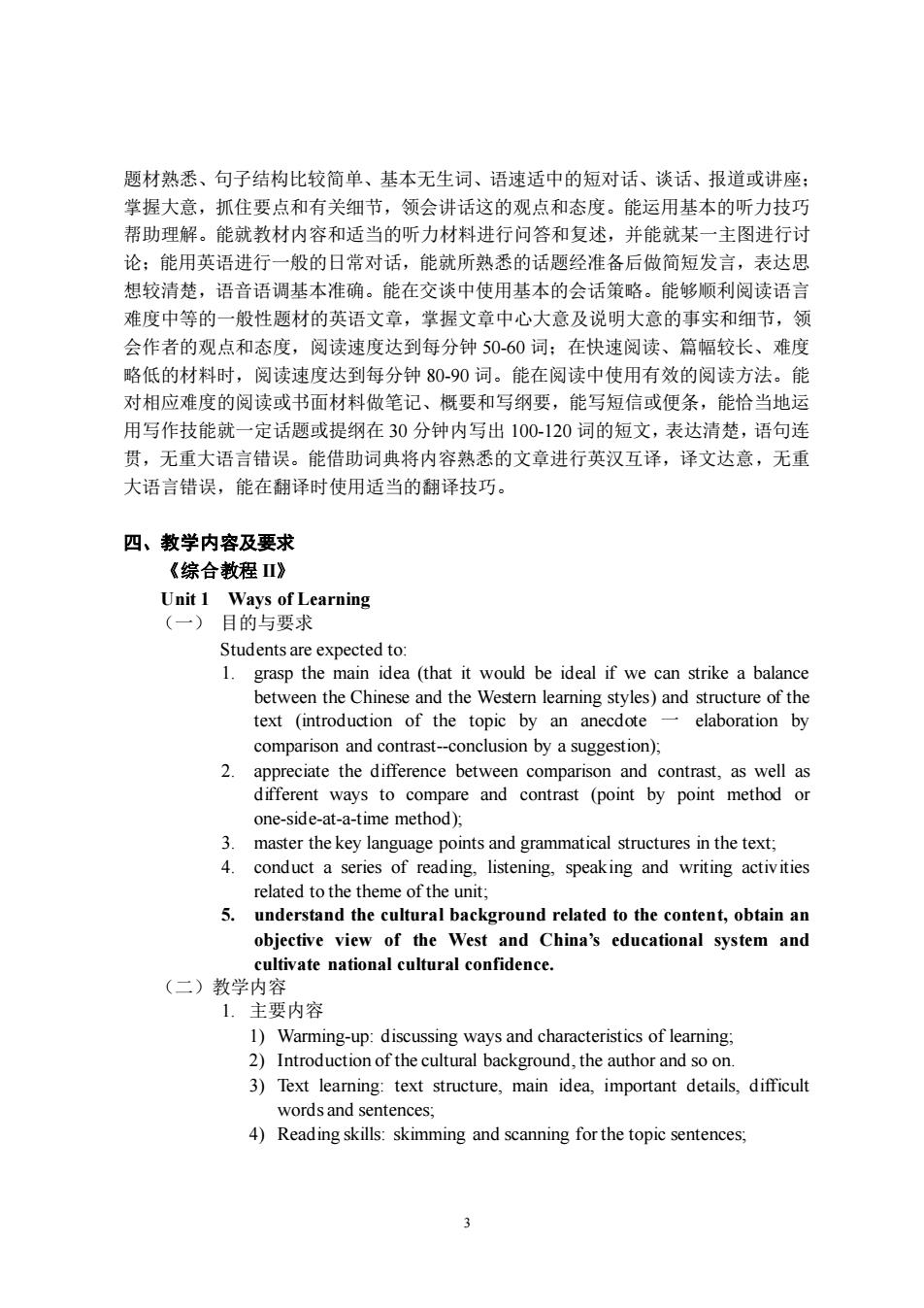
题材熟悉、句子结构比较简单、基本无生词、语速适中的短对话、谈话、报道或讲座: 掌握大意,抓住要点和有关细节,领会讲话这的观点和态度。能运用基本的听力技巧 帮助理解。能就教材内容和适当的听力材料进行问答和复述,并能就某一主图进行讨 论:能用英语进行一般的日常对话,能就所熟悉的话题经准备后做简短发言,表达思 想较清楚,语音语调基本准确。能在交谈中使用基本的会话策略。能够顺利阅读语言 难度中等的一般性题材的英语文章,掌握文章中心大意及说明大意的事实和细节,领 会作者的观点和态度,阅读速度达到每分钟5060词:在快速阅读、篇幅较长,难度 略低的材料时,阅读速度达到每分钟80-90词。能在阅读中使用有效的阅读方法。能 对相应难度的阅读或书面材料做笔记、概要和写纲要,能写短信或便条,能恰当地运 用写作技能就一定话题或提纲在30分钟内写出100-120词的短文,表达清楚,语句连 贯,无重大语言错误。能借助词典将内容熟悉的文章进行英汉互译,译文达意,无重 大语言错误,能在翻译时使用适当的翻译技巧。 四、教学内容及要求 《综合教程》 Unit 1 Ways of Learning (一)目的与要求 Studentsare expected grasp the main idea (that it would be ideal if we can strike a balance between the Chinese and the Western learning styles)and structure of the text (introduction of the topic by an anecdote elaboration by comparison and contrast--conclusion by a suggestion), 2. and contrast,as a ways to compare an contrast (point by point method or one-side-at-a-time method ) 3.master the key language points and grammatical structures in the text; 4.conduct a series of reading.listening.speaking and writing activities related to the theme of the uni 5. understand the cultural background related to the content,obtain an objective view of the West and China's educational system and cultivate national cultural confidence. (二)教学内容 1.主要内容 )Warmin up:discussing ways and characteristics of eain 2)Introduction of the cultural background,the author and soon 3)Text learning:text structure.main idea.important details.difficult words and sentences 4)Reading skills:skimming and scanning for the topic sentences 3
3 题材熟悉、句子结构比较简单、基本无生词、语速适中的短对话、谈话、报道或讲座; 掌握大意,抓住要点和有关细节,领会讲话这的观点和态度。能运用基本的听力技巧 帮助理解。能就教材内容和适当的听力材料进行问答和复述,并能就某一主图进行讨 论;能用英语进行一般的日常对话,能就所熟悉的话题经准备后做简短发言,表达思 想较清楚,语音语调基本准确。能在交谈中使用基本的会话策略。能够顺利阅读语言 难度中等的一般性题材的英语文章,掌握文章中心大意及说明大意的事实和细节,领 会作者的观点和态度,阅读速度达到每分钟 50-60 词;在快速阅读、篇幅较长、难度 略低的材料时,阅读速度达到每分钟 80-90 词。能在阅读中使用有效的阅读方法。能 对相应难度的阅读或书面材料做笔记、概要和写纲要,能写短信或便条,能恰当地运 用写作技能就一定话题或提纲在 30 分钟内写出 100-120 词的短文,表达清楚,语句连 贯,无重大语言错误。能借助词典将内容熟悉的文章进行英汉互译,译文达意,无重 大语言错误,能在翻译时使用适当的翻译技巧。 四、教学内容及要求 《综合教程 II》 Unit 1 Ways of Learning (一) 目的与要求 Students are expected to: 1. grasp the main idea (that it would be ideal if we can strike a balance between the Chinese and the Western learning styles) and structure of the text (introduction of the topic by an anecdote 一 elaboration by comparison and contrast--conclusion by a suggestion); 2. appreciate the difference between comparison and contrast, as well as different ways to compare and contrast (point by point method or one-side-at-a-time method); 3. master the key language points and grammatical structures in the text; 4. conduct a series of reading, listening, speaking and writing activities related to the theme of the unit; 5. understand the cultural background related to the content, obtain an objective view of the West and China’s educational system and cultivate national cultural confidence. (二)教学内容 1. 主要内容 1) Warming-up: discussing ways and characteristics of learning; 2) Introduction of the cultural background, the author and so on. 3) Text learning: text structure, main idea, important details, difficult words and sentences; 4) Reading skills: skimming and scanning for the topic sentences;
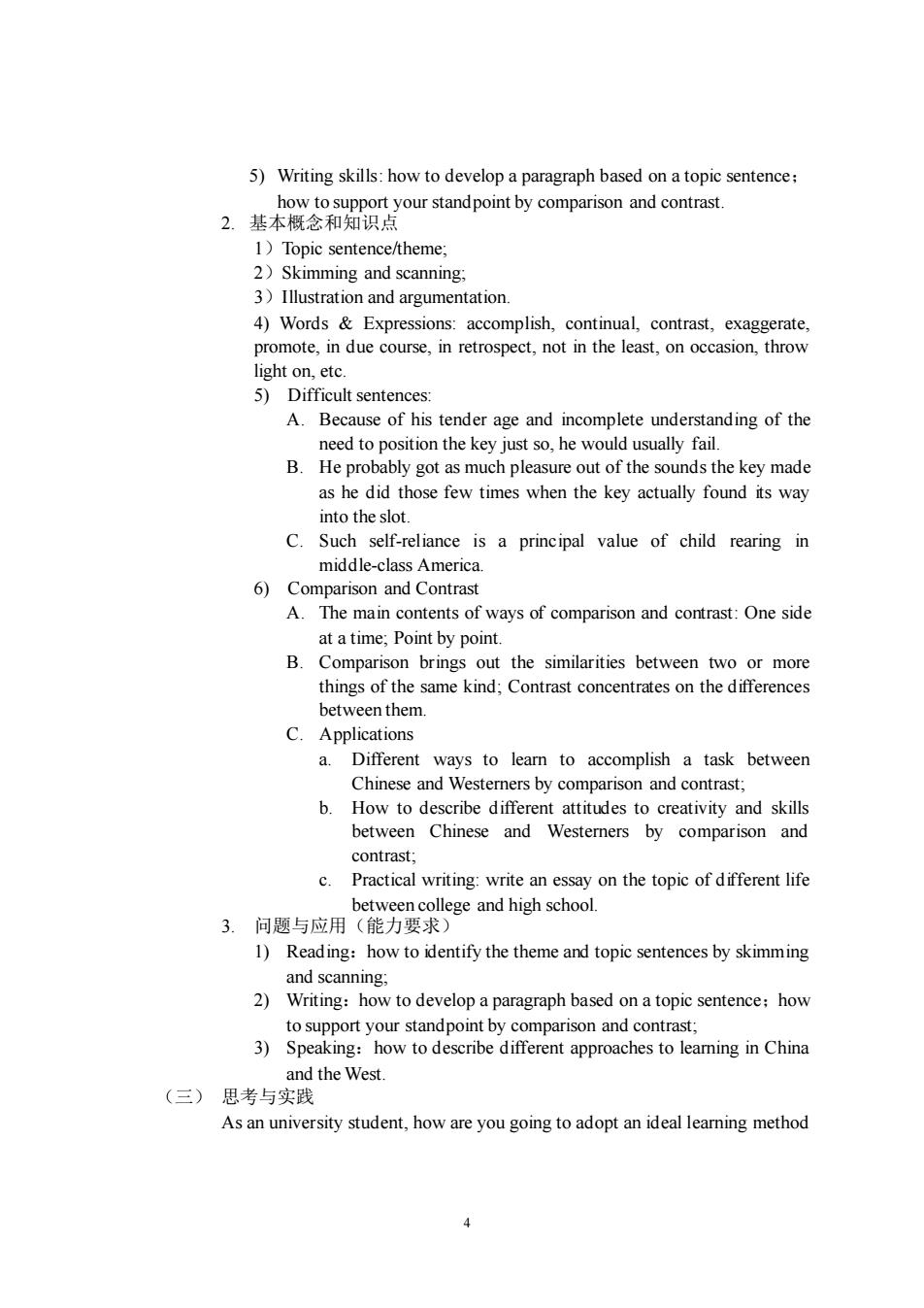
5)Writing skills:how to develop a paragraph based on a topic sentence: 2基本9和粥9our6 bomp 1)Topic sentence/theme. 2) imming and scanning 3)Illustration and argumentation 4)Words Expressions:accomplish,continual,contrast,exaggerate, promote,in due course,in retrospect,not in the least,on occasion,throw light on etc 5)Difficult sentences A.Because of his tender age and incomplete understanding of the need to position the key just so,he would usually fail. B.He probably got as much pleasure out of the sounds the key made as he did those few times when the key actually found its way into the slot. C. Such self-reliance is a principal value of child rearing in middle-class America 6)Comparison and Contrast A.The main contents of ways of comparison and contrast:One side atatime:Point by point. B. n brings out the similarities between two or more things of the same kind;Contrast concentrates on the differences between them C.Applications Different nese and Westerners by comparison and contr accomplish a task between 6 How to describe different attitudes to creativity and skills between Chinese and Westerners by comparison and contrast: c. Practical writing:write an essay on the topic of different life 3.问恩与应用能要 lege and high school. 1)Reading:how to identify the theme and topic sentences by skimming and scanning: 2)Writing:how to develop a paragraph based on a topic sentence:how nparison and contrast. ibe diffe approaches to leaming in China and the West (三)思考与实践 As an university student,how are you going to adopt an ideal learning method 4
4 5) Writing skills: how to develop a paragraph based on a topic sentence; how to support your standpoint by comparison and contrast. 2. 基本概念和知识点 1)Topic sentence/theme; 2)Skimming and scanning; 3)Illustration and argumentation. 4) Words & Expressions: accomplish, continual, contrast, exaggerate, promote, in due course, in retrospect, not in the least, on occasion, throw light on, etc. 5) Difficult sentences: A. Because of his tender age and incomplete understanding of the need to position the key just so, he would usually fail. B. He probably got as much pleasure out of the sounds the key made as he did those few times when the key actually found its way into the slot. C. Such self-reliance is a principal value of child rearing in middle-class America. 6) Comparison and Contrast A. The main contents of ways of comparison and contrast: One side at a time; Point by point. B. Comparison brings out the similarities between two or more things of the same kind; Contrast concentrates on the differences between them. C. Applications a. Different ways to learn to accomplish a task between Chinese and Westerners by comparison and contrast; b. How to describe different attitudes to creativity and skills between Chinese and Westerners by comparison and contrast; c. Practical writing: write an essay on the topic of different life between college and high school. 3. 问题与应用(能力要求) 1) Reading:how to identify the theme and topic sentences by skimming and scanning; 2) Writing:how to develop a paragraph based on a topic sentence;how to support your standpoint by comparison and contrast; 3) Speaking:how to describe different approaches to learning in China and the West. (三) 思考与实践 As an university student, how are you going to adopt an ideal learning method
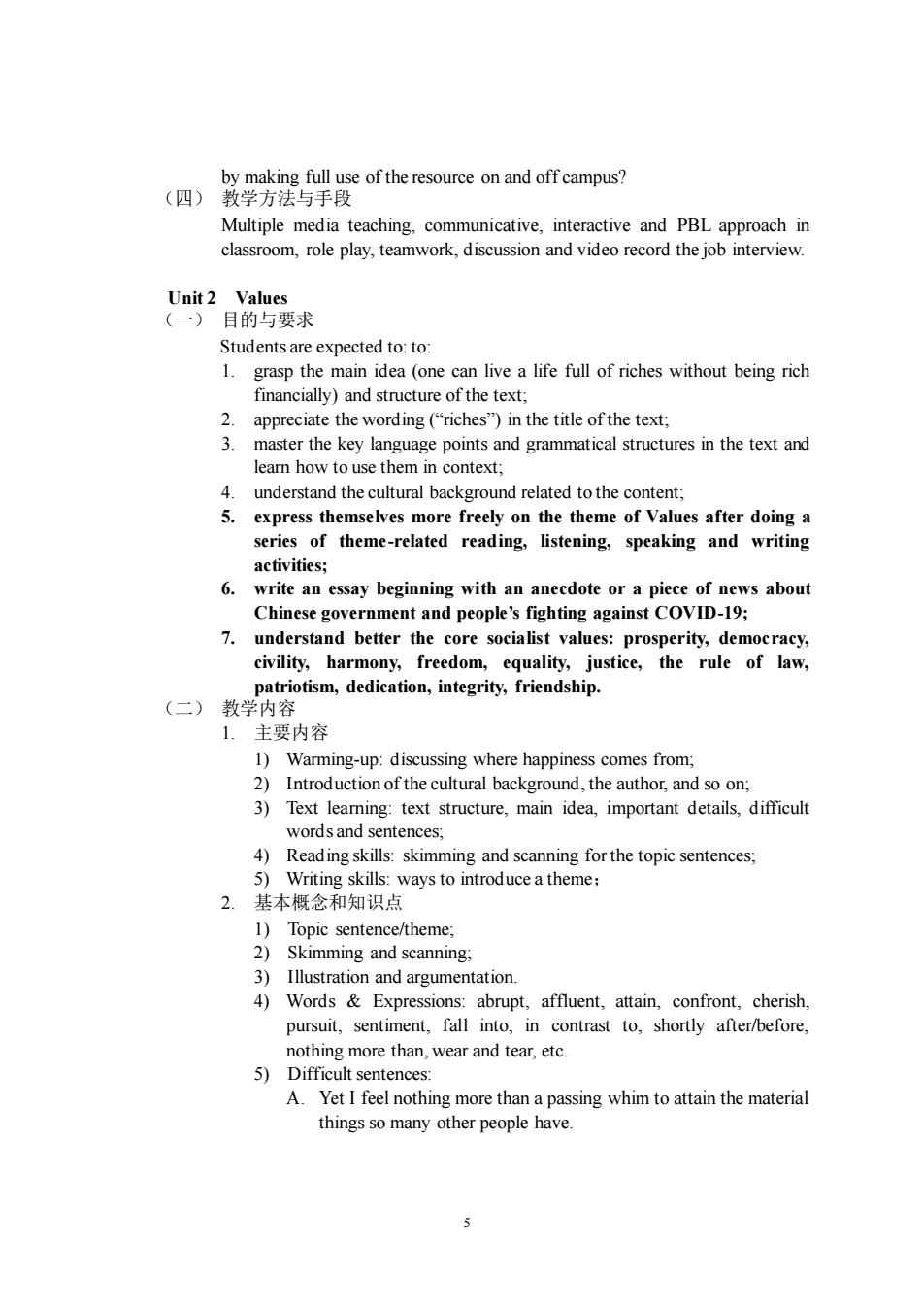
by making full use of the resource on and off campus? (四)教学方法与手段 Mutipe media teaching.and PBLapproach in classroom,ole play,teamwork,discussion and video record the job interview Unit 2 Values (一)目的与要求 Students are expected to:to: grasp the main idea (one can live a life full of riches without being rich i ncially)and str cture of the text appreciate the wording ("riches)in the title of the text: 3. master the key language points and grammatical structures in the text and learn how to use them in context 5. express themselves more freely on the theme of Values after doing a series of theme-related reading,listening,speaking and writing activities: 6.write an essay beginning with an anecdote or a piece of news about Chinese government and people's fighting against COVID-19; 7. understand better the cor socialist values prosp rity,democracy. civility,harmony,freedom,equality,justice,the rule of law, patriotism,dedication,integrity,friendship. (二)教学内容 1主要内容 -NR。ebee网 ing where happinessc comes from Intro 3)Text learning:text structure,main idea,important details,difficult words and sentences: 4)Reading skills:skimming and scanning for the topic sentences, 5)Writing skills:ways to introduce a theme: 2.基本概念和知识点 1)Topic sentence/theme; 2)Skimming and scanning: 3)Illustration and argumentation. 4)Words &Expressions:abrupt,affluent,attain,confront,cherish. uit ent,fall int contrast to,shortly afte nothing more than,wear and tear,etc. 5)Difficult sentences: A.Yet I feel nothing more than a passing whim to attain the material things so many other people have. 5
5 by making full use of the resource on and off campus? (四) 教学方法与手段 Multiple media teaching, communicative, interactive and PBL approach in classroom, role play, teamwork, discussion and video record the job interview. Unit 2 Values (一) 目的与要求 Students are expected to: to: 1. grasp the main idea (one can live a life full of riches without being rich financially) and structure of the text; 2. appreciate the wording (“riches”) in the title of the text; 3. master the key language points and grammatical structures in the text and learn how to use them in context; 4. understand the cultural background related to the content; 5. express themselves more freely on the theme of Values after doing a series of theme-related reading, listening, speaking and writing activities; 6. write an essay beginning with an anecdote or a piece of news about Chinese government and people’s fighting against COVID-19; 7. understand better the core socialist values: prosperity, democracy, civility, harmony, freedom, equality, justice, the rule of law, patriotism, dedication, integrity, friendship. (二) 教学内容 1. 主要内容 1) Warming-up: discussing where happiness comes from; 2) Introduction of the cultural background, the author, and so on; 3) Text learning: text structure, main idea, important details, difficult words and sentences; 4) Reading skills: skimming and scanning for the topic sentences; 5) Writing skills: ways to introduce a theme; 2. 基本概念和知识点 1) Topic sentence/theme; 2) Skimming and scanning; 3) Illustration and argumentation. 4) Words & Expressions: abrupt, affluent, attain, confront, cherish, pursuit, sentiment, fall into, in contrast to, shortly after/before, nothing more than, wear and tear, etc. 5) Difficult sentences: A. Yet I feel nothing more than a passing whim to attain the material things so many other people have
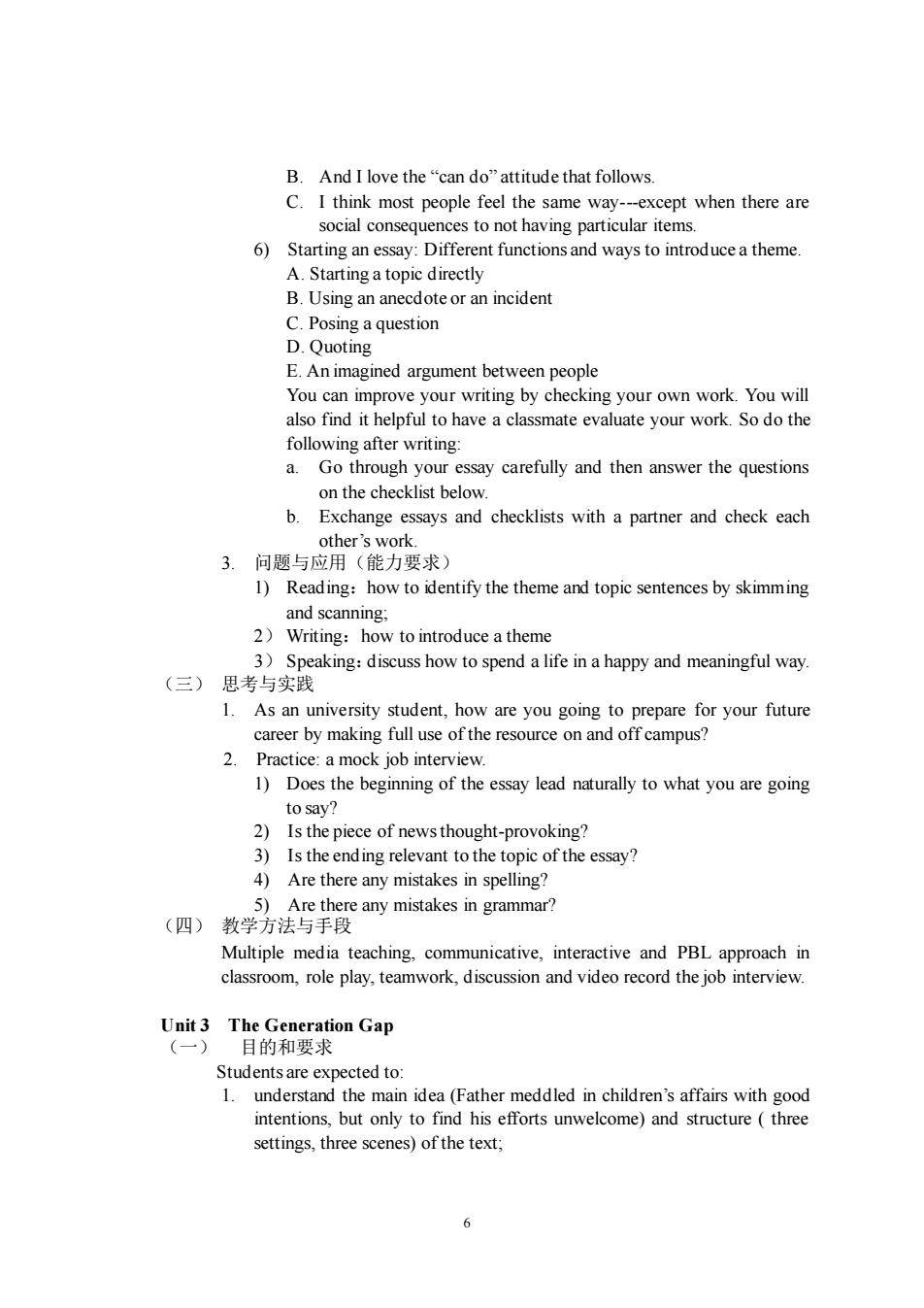
B.And I love the“can do”attitude that follows. C.I think most people feel the same way---except when there are social consequences to not having particular items. 0 Starting ane Different function sand ways to introduce a theme A.S artinga topicdirectl B.Using an anecdote or an incident C.Posing a question D.Ouoting E.An imagined argument between people You can m you r writing by checking your own work.You will also find it helpful to have a classmate evaluate your work.So do the following after writing a.Go through your essay carefully and then answer the questions on the checklist below b Exchange essays and checklists with a partner and check each 3. 问题与应用《能刀要求) 1)Reading:how to identify the theme and topic sentences by skimming and scanning: 2)Writing:how to introduce a theme 3)Speaking:discuss how to spend a life in a happy and meaningful way. (三)思考与实践 1.As an university student.how are you going to prepare for your future career by making full use of the resource on and off campus? 2 the beginning of the essay lead naturally to what you are going to say 2)Is the piece of news thought-provoking? 3)Is the ending relevant to the topic of the essay? 4)Are there any mistakes in spelling? e any mistakes in grammar? Multiple media teaching,communicative,interactive and PBL approach in classroom,role play,teamwork,discussion and video record the job interview. Unit 3 The Generation Gap 目的和要求 ected to the main idea (Father meddled in children's affairs with good intentions,but only to find his efforts unwelcome)and structure three settings,three scenes)of the text. 6
6 B. And I love the “can do” attitude that follows. C. I think most people feel the same way---except when there are social consequences to not having particular items. 6) Starting an essay: Different functions and ways to introduce a theme. A. Starting a topic directly B. Using an anecdote or an incident C. Posing a question D. Quoting E. An imagined argument between people You can improve your writing by checking your own work. You will also find it helpful to have a classmate evaluate your work. So do the following after writing: a. Go through your essay carefully and then answer the questions on the checklist below. b. Exchange essays and checklists with a partner and check each other’s work. 3. 问题与应用(能力要求) 1) Reading:how to identify the theme and topic sentences by skimming and scanning; 2) Writing:how to introduce a theme 3) Speaking:discuss how to spend a life in a happy and meaningful way. (三) 思考与实践 1. As an university student, how are you going to prepare for your future career by making full use of the resource on and off campus? 2. Practice: a mock job interview. 1) Does the beginning of the essay lead naturally to what you are going to say? 2) Is the piece of news thought-provoking? 3) Is the ending relevant to the topic of the essay? 4) Are there any mistakes in spelling? 5) Are there any mistakes in grammar? (四) 教学方法与手段 Multiple media teaching, communicative, interactive and PBL approach in classroom, role play, teamwork, discussion and video record the job interview. Unit 3 The Generation Gap (一) 目的和要求 Students are expected to: 1. understand the main idea (Father meddled in children’s affairs with good intentions, but only to find his efforts unwelcome) and structure ( three settings, three scenes) of the text;
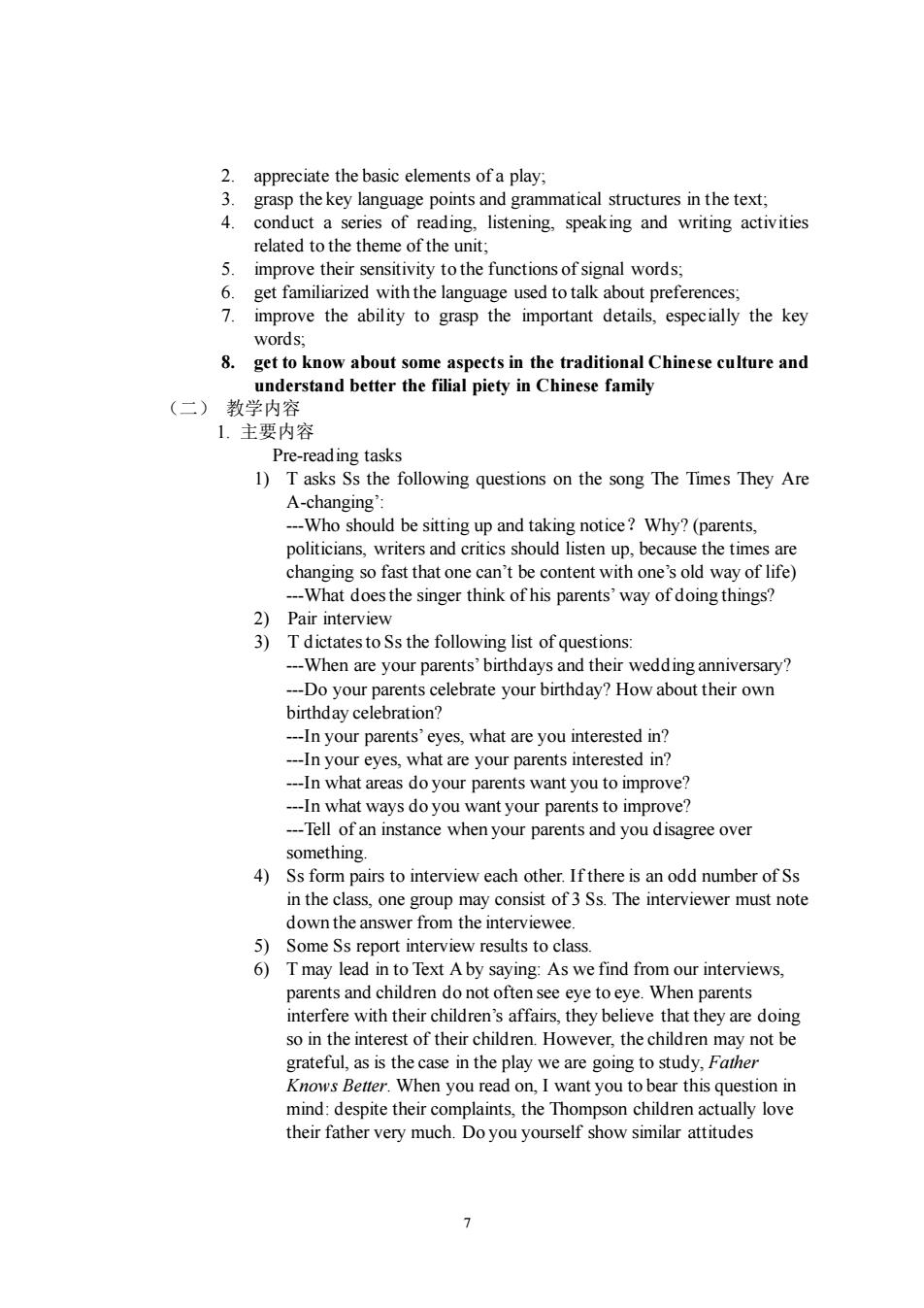
2.appreciate the basic elements of a play, 3.grasp the key language points and grammatical structures in the text; 4.conduct a series of reading,listening.speaking and writing activities related to the theme of the unit: 5 improve their sensitivity to the functions of signal words 6 get wth the nu used to talk about preferences the ability to grasp the important details,especially the key words 8.get to know about some aspects in the traditional Chinese culture and understand better the filial piety in Chinese family (二)教学内容 1.主要内容 Pre-read ing tasks 1)T asks Ss the following questions on the song The Times They Are A-changing'. ---Who should be sitting up and taking notice?Why?(parents criticss ould listen he time one content with one old way or e t does the singer think of his parents'way of doing things? 2)Pair interview 3)T dictates to Ss the following list of questions ---When are your parents'birthdays and their wedding anniversary? --Do your parents celebrate your birthday?How about their own birthday celebration? -In your pa ents'eve s,what are you inte rested in? r eyes what a re yo f paren ested in? In wha t areas do your r parents war t you to improve n wh ways do you ant your parents to improve ---Tell of an instance when your parents and you disagree over something. 4)Ss form pairs to interview each other.If there is an odd number of Ss in the class,one group may consist of 3 Ss.The interviewer must note down the answer from the interviewee ) Some ss report interview results to class Tmay lead in toText Aby 61 ing:As we find from our interviews. nts and childr e eye to e w parents interfe e with their s,they be ve th they are doin so in the interes t of their c ren.However,the childr may not be grateful,as is the case in the play we are going to study,Father Knows Better.When you read on,I want you to bear this question in mind:despite their complaints,the Thompson children actually love their father very much.Do you yourself show similar attitudes 7
7 2. appreciate the basic elements of a play; 3. grasp the key language points and grammatical structures in the text; 4. conduct a series of reading, listening, speaking and writing activities related to the theme of the unit; 5. improve their sensitivity to the functions of signal words; 6. get familiarized with the language used to talk about preferences; 7. improve the ability to grasp the important details, especially the key words; 8. get to know about some aspects in the traditional Chinese culture and understand better the filial piety in Chinese family (二) 教学内容 1. 主要内容 Pre-reading tasks 1) T asks Ss the following questions on the song The Times They Are A-changing’: ---Who should be sitting up and taking notice?Why? (parents, politicians, writers and critics should listen up, because the times are changing so fast that one can’t be content with one’s old way of life) ---What does the singer think of his parents’ way of doing things? 2) Pair interview 3) T dictates to Ss the following list of questions: ---When are your parents’ birthdays and their wedding anniversary? ---Do your parents celebrate your birthday? How about their own birthday celebration? ---In your parents’ eyes, what are you interested in? ---In your eyes, what are your parents interested in? ---In what areas do your parents want you to improve? ---In what ways do you want your parents to improve? ---Tell of an instance when your parents and you disagree over something. 4) Ss form pairs to interview each other. If there is an odd number of Ss in the class, one group may consist of 3 Ss. The interviewer must note down the answer from the interviewee. 5) Some Ss report interview results to class. 6) T may lead in to Text A by saying: As we find from our interviews, parents and children do not often see eye to eye. When parents interfere with their children’s affairs, they believe that they are doing so in the interest of their children. However, the children may not be grateful, as is the case in the play we are going to study, Father Knows Better. When you read on, I want you to bear this question in mind: despite their complaints, the Thompson children actually love their father very much. Do you yourself show similar attitudes
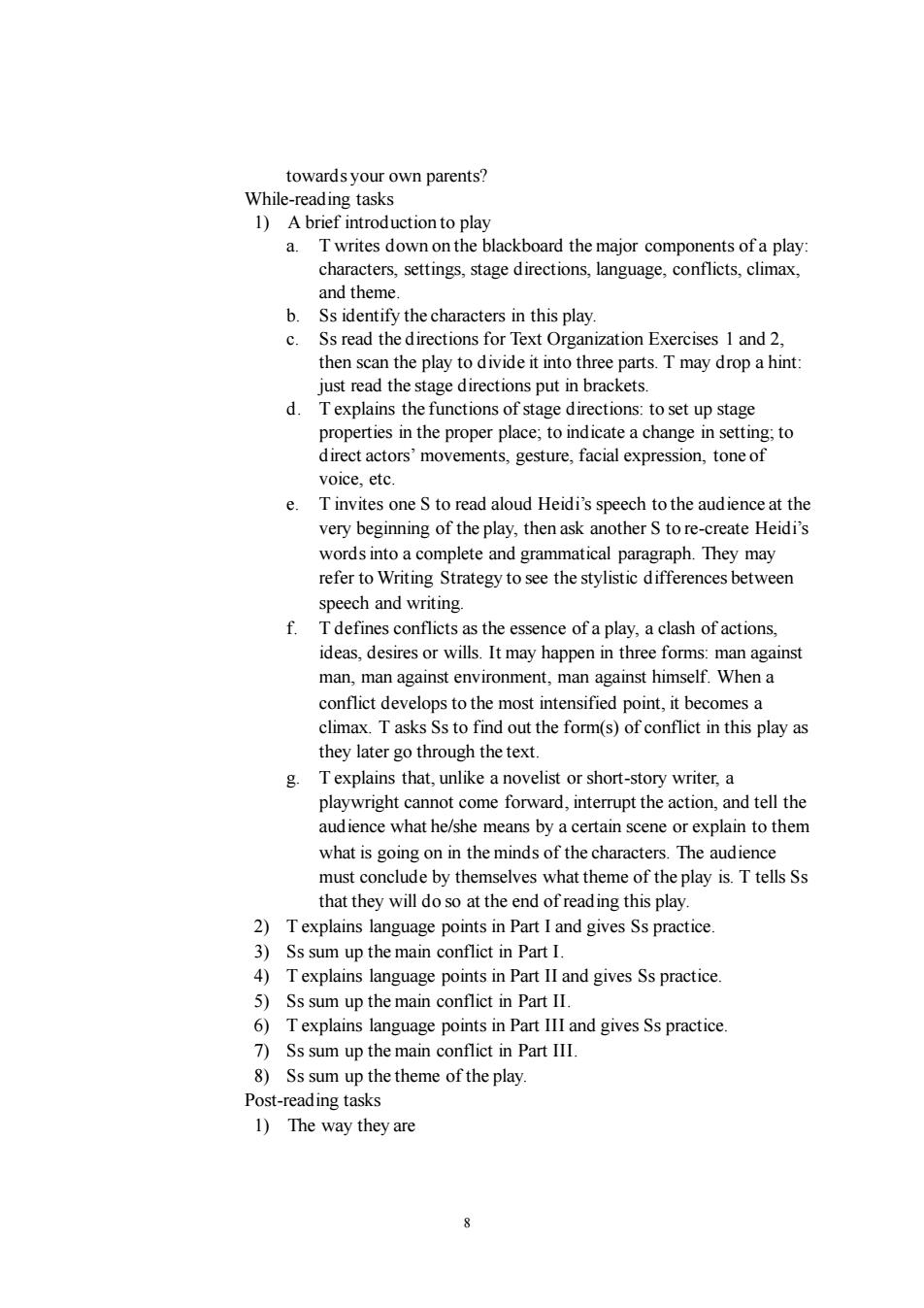
towards your own parents? While-reading tasks 1)A brief introduction to play a.Twrites down on the blackboard the major components of a play: characters,settings,stage directions,language,conflicts,climax, and theme Ss identify the characters in this play c Ss read the directions for Text Organization Exercises 1 and 2 e parts.Tmay drop a hint stage a T explains the functions of stage directions:to set up stage properties in the proper place;to indicate a change in setting:to direct actors'movements,gesture,facial expression,tone of voice etc e.Tinvites one S to read aloud Heidi's speech to the audience at the very beginning of the play,then ask anotherS tore-create Heidi's words into a complete and grammatical paragraph.They may refer to Wrting Strategy to see the stylistic differences between speech and writing f Tdefines conflicts as the essence of a play,a clash of actions ideas,desires or wills.It may happen in three forms:man agains man,man against environment,man against himself.When a conflict develops to the most intensified point it becomes a climax.T asks Ss to find out the form(s) conflict int his play as they later go through the text g.Texplains that,unlike a novelist or short-story writer.a playwright cannot come forward.interrupt the action.and tell the audience what he/she means by a certair ene or explain to them what is going on in the minds of the characters.The audience must conclude by themselves what theme of the play is.T tells Ss that they will do so at the end of reading this play. 2)Texplains language points in Part Iand gives Ss pra ctice Ss sum up the main conflict in Part 4)T explains language points in Part II and gives Ss practice 5)Ss sum up the main conflict in Part II. 6)Texplains language points in Part III and gives Ss practice 7)Ss sum up the m ain conflict in Part III 8)Ss sum up the theme of the play. Post-reading tasks 1)The way they are 8
8 towards your own parents? While-reading tasks 1) A brief introduction to play a. T writes down on the blackboard the major components of a play: characters, settings, stage directions, language, conflicts, climax, and theme. b. Ss identify the characters in this play. c. Ss read the directions for Text Organization Exercises 1 and 2, then scan the play to divide it into three parts. T may drop a hint: just read the stage directions put in brackets. d. T explains the functions of stage directions: to set up stage properties in the proper place; to indicate a change in setting; to direct actors’ movements, gesture, facial expression, tone of voice, etc. e. T invites one S to read aloud Heidi’s speech to the audience at the very beginning of the play, then ask another S to re-create Heidi’s words into a complete and grammatical paragraph. They may refer to Writing Strategy to see the stylistic differences between speech and writing. f. T defines conflicts as the essence of a play, a clash of actions, ideas, desires or wills. It may happen in three forms: man against man, man against environment, man against himself. When a conflict develops to the most intensified point, it becomes a climax. T asks Ss to find out the form(s) of conflict in this play as they later go through the text. g. T explains that, unlike a novelist or short-story writer, a playwright cannot come forward, interrupt the action, and tell the audience what he/she means by a certain scene or explain to them what is going on in the minds of the characters. The audience must conclude by themselves what theme of the play is. T tells Ss that they will do so at the end of reading this play. 2) T explains language points in Part I and gives Ss practice. 3) Ss sum up the main conflict in Part I. 4) T explains language points in Part II and gives Ss practice. 5) Ss sum up the main conflict in Part II. 6) T explains language points in Part III and gives Ss practice. 7) Ss sum up the main conflict in Part III. 8) Ss sum up the theme of the play. Post-reading tasks 1) The way they are
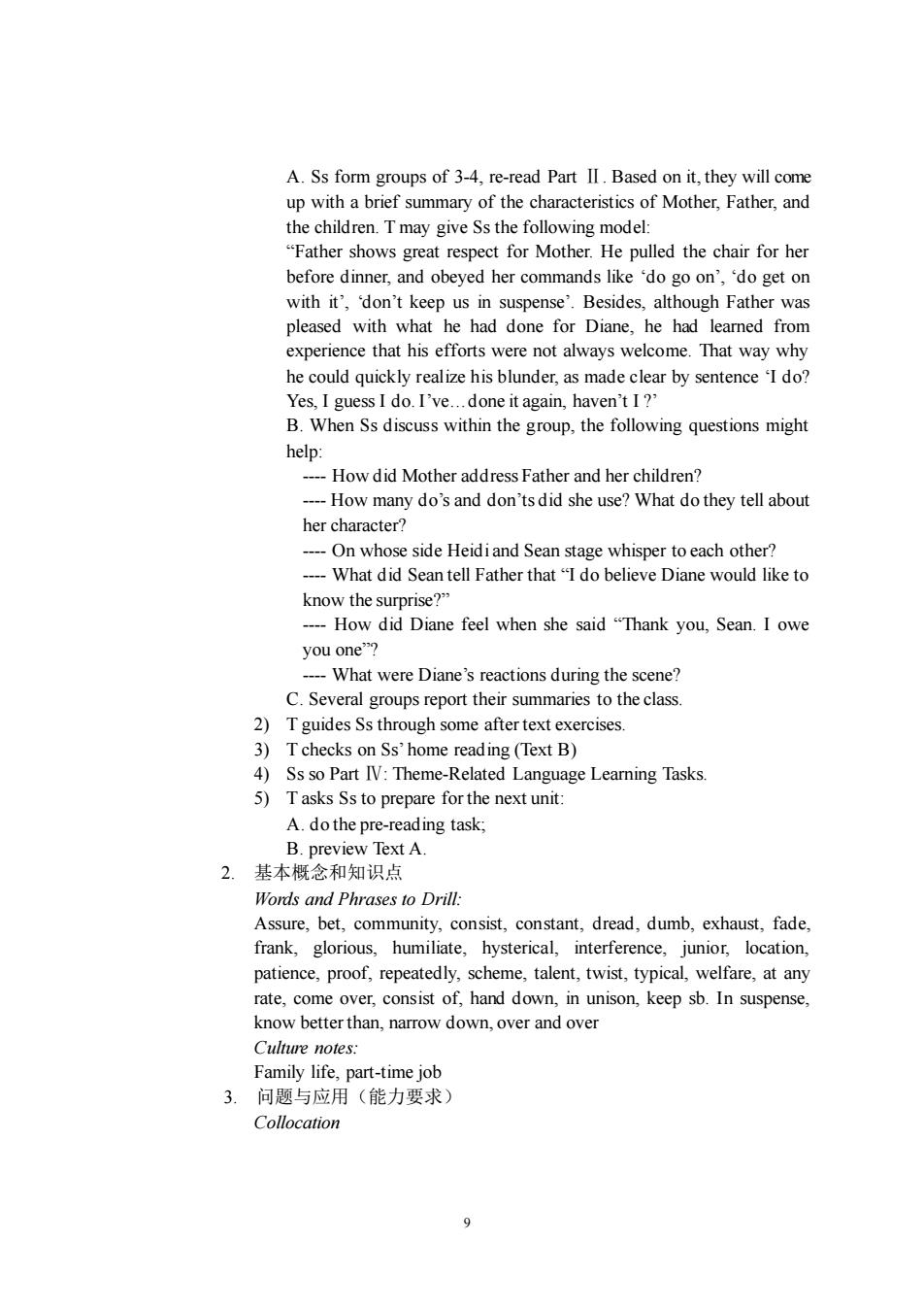
A.Ss form groups of 3-4,re-read Part II.Based on it,they will come up with a brief summary of the characteristics of Mother.Father.and children.Tmay give Ss the follow Father sorectfor Mod the shair for her before dinner,and obeyed her commands like 'do go on','do get on with it'don't keep us in suspense'Besides although father was pleased with what he had done for Diane,he had leamed fr experience that his efforts were not always welcome.That way why he could quickly realize his blunder,as made clear by sentence 'I do? Yes,I guess I do.I've...done it again,haven't I?' B.When Ss discuss within the group,the following questions might help ----How did Mother address Father and her children? --How many do's and don'ts did she use?What do they tell about her character? On whose side Heidiand Sean stage whisper to each other? ---What did Sean tell Father that"I do believe Diane would like to know the surprise?" --How did Diane feel when she said "Thank you,Sean.I owe you one"? -What were Diane's reactions during the scene? C.Several groups report their summaries to the class. 2)T guides Ss through some after text exercises. 3 Tchecks on Ss' home re ading(Text B) 4)Ss so Part IV:Theme-Related Language Learning Tasks. 5)Tasks Ss to prepare for the next unit: A.do the pre-reading task; Text A. 2. 基本概念和知识点 Words and Phrases to Drill: Assure,bet,community,consist,constant,dread,dumb,exhaust,fade. frank. glorious, humiliate hysterical,interference junior, location patience,proof,repeatedly,scheme,talent,twist,typical,welfare,at any rate,come over,consist of,hand down,in unison,keep sb.In suspense, know better than.narrow down.over and over notes: Family lfe,part-time job 3.问题与应用(能力要求) Collocation
9 A. Ss form groups of 3-4, re-read Part Ⅱ. Based on it, they will come up with a brief summary of the characteristics of Mother, Father, and the children. T may give Ss the following model: “Father shows great respect for Mother. He pulled the chair for her before dinner, and obeyed her commands like ‘do go on’, ‘do get on with it’, ‘don’t keep us in suspense’. Besides, although Father was pleased with what he had done for Diane, he had learned from experience that his efforts were not always welcome. That way why he could quickly realize his blunder, as made clear by sentence ‘I do? Yes, I guess I do. I’ve…done it again, haven’t I ?’ B. When Ss discuss within the group, the following questions might help: ---- How did Mother address Father and her children? ---- How many do’s and don’ts did she use? What do they tell about her character? ---- On whose side Heidi and Sean stage whisper to each other? ---- What did Sean tell Father that “I do believe Diane would like to know the surprise?” ---- How did Diane feel when she said “Thank you, Sean. I owe you one”? ---- What were Diane’s reactions during the scene? C. Several groups report their summaries to the class. 2) T guides Ss through some after text exercises. 3) T checks on Ss’ home reading (Text B) 4) Ss so Part Ⅳ: Theme-Related Language Learning Tasks. 5) T asks Ss to prepare for the next unit: A. do the pre-reading task; B. preview Text A. 2. 基本概念和知识点 Words and Phrases to Drill: Assure, bet, community, consist, constant, dread, dumb, exhaust, fade, frank, glorious, humiliate, hysterical, interference, junior, location, patience, proof, repeatedly, scheme, talent, twist, typical, welfare, at any rate, come over, consist of, hand down, in unison, keep sb. In suspense, know better than, narrow down, over and over Culture notes: Family life, part-time job 3. 问题与应用(能力要求) Collocation

Adjective+to do eager to find out..,more than willing to answer...,etc Subjunctive mood:be that as it may.He'd insist he give you a call.et Acting out the plav There are seven characters in the play.Now form groups of seven and act out the play.If the total number of the class cannot be divided by seven, some students in the las group will take more than one role Essay writing Write a letter to your parents/teachers,etc.to explain why you have to do something contrary to their expectations. () 思考与实践 1.Learn Text B in groups and finish the exercises after it. 2.Read the three passages in unit 3 of the Reading Course Book 2,and finish the exercises. Do the fast reading exercises in unit 3 of the Fast Reading Course Book2 (四)教学方法与手 Multiple media teaching,communicative,interactive and PBL approach in classroom.role play.teamwork.discussion and interview. Unit 4 The Virtual World 教学目的和要求 Students will be able to 1. leam some rules of in erpre vocabulary and usage related to computers and the Intemet in English master the new words and expressions in Text A; 3 appreciate a writing style-expository writing: clude the str c ture of text a 5.conduct a series of reading.listening.speaking and writing activities related to the theme of the unit 6.improve their ability to catch key words. 7 get familiarized with the language needed to ask people about their on and to give opinion (二)教学内容 1.主要内容 owing questions on the poem Surfing the Internet -What was the hero doing when his boss came in?(surfing the Internet)-How did he act in front ofhis boss?(He pretended to be 10
10 Adjective+ to do eager to find out… , more than willing to answer…, etc. Usage Subjunctive mood: be that as it may; He’d insist he give you a call. etc. Acting out the play There are seven characters in the play. Now form groups of seven and act out the play. If the total number of the class cannot be divided by seven, some students in the last group will take more than one role. Essay writing Write a letter to your parents/teachers, etc. to explain why you have to do something contrary to their expectations. (三) 思考与实践 1. Learn Text B in groups and finish the exercises after it. 2. Read the three passages in unit 3 of the Reading Course Book 2, and finish the exercises. 3. Do the fast reading exercises in unit 3 of the Fast Reading Course Book 2. (四) 教学方法与手段 Multiple media teaching, communicative, interactive and PBL approach in classroom, role play, teamwork, discussion and interview. Unit 4 The Virtual World (一) 教学目的和要求 Students will be able to: 1. learn some rules of interpreting new vocabulary and usage related to computers and the Internet in English; 2. master the new words and expressions in Text A; 3. appreciate a writing style-expository writing; 4. conclude the structure of Text A; 5. conduct a series of reading, listening, speaking and writing activities related to the theme of the unit. 6. improve their ability to catch key words. 7. get familiarized with the language needed to ask people about their opinion and to give opinion. (二) 教学内容 1. 主要内容 Pre-reading tasks 1) T asks Ss the following questions on the poem Surfing the Internet: —What was the hero doing when his boss came in? (surfing the Internet) —How did he act in front of his boss? (He pretended to be